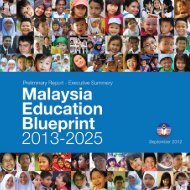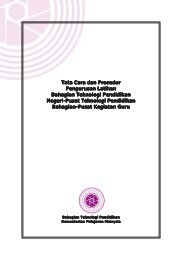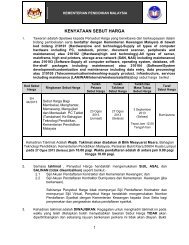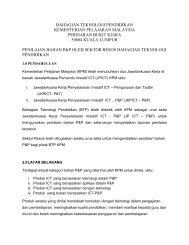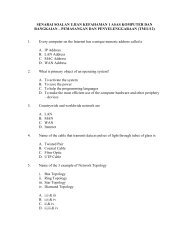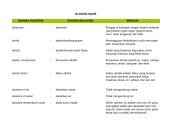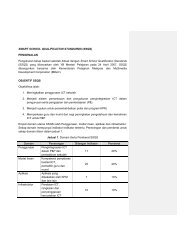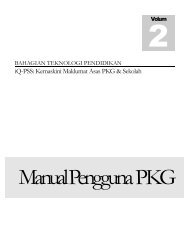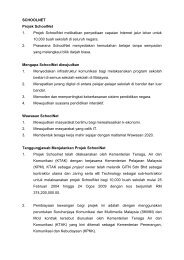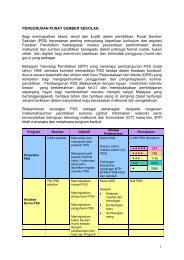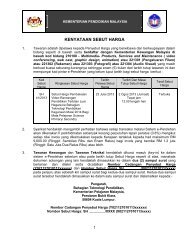Project Based Learning Handbook
Project Based Learning Handbook
Project Based Learning Handbook
Create successful ePaper yourself
Turn your PDF publications into a flip-book with our unique Google optimized e-Paper software.
ContentsForeword(v)Introduction1<strong>Project</strong>-<strong>Based</strong> <strong>Learning</strong> (PBL)What is <strong>Project</strong>-based <strong>Learning</strong>?Why is <strong>Project</strong>-based <strong>Learning</strong> Important?<strong>Project</strong>-based <strong>Learning</strong> in Malaysian SchoolsHow to implement <strong>Project</strong>-based <strong>Learning</strong>?361018The Essential Question (EQ)Crafting the essential questionChecklist for framing an effective questionWhy do we need essential questions?Examples of EQTen functions of essential questionsAlternative AssessmentCharacteristics of alternative assessmentAssessment ToolsTypes of alternative assessmentAlternative assessment in Malaysia262829313235363638ontentsContentsCiii
RubricsWhat are rubrics?Why use rubrics?Creating rubricsTips on rubrics39434647For <strong>Project</strong>-<strong>Based</strong> <strong>Learning</strong> Users“Dos and Don’ts in PBL”Frequently Asked Questions (FAQ)4851List of ResourcesAppendixContributors(vi)(ix)(xi)ContentsContentsiv
ForewordF o r e w o r d
ForewordThere is a need to use multi-facetedapproaches to deliver content as outlinedin the national curriculum, and todevelop soft skills among students. Tofulfill this need, the EducationalTechnology Division of the Ministry ofEducation, Malaysia has prepared this<strong>Project</strong>-based <strong>Learning</strong> <strong>Handbook</strong>. TheMinistry of Education has implemented“Program Pembestarian Sekolah” or “Making Schools Smart”Programme for all Malaysian schools under the NinthMalaysian Plan (RMK-9). This programme calls for innovationin areas of teaching and learning by integrating technology.This handbook is timely as it gives a brief overview of <strong>Project</strong>based<strong>Learning</strong> (PBL), how it can be used to achieve 21stcentury skills, and activity-based learning to encourageself-directed, self-paced and self-accessed learning amongstudents.Besides providing useful information on PBL, ideas toaddress issues and overcome obstacles are included toensure teachers practise PBL.The Educational Technology Division wishes to thank thegroup of dedicated educational officers and representativesfrom the private sector who have shared their expertise andexperience, and who have worked so diligently to make thishandbook possible.DATO’ HAJI YUSOFF BIN HARUNDirectorEducational Technology DivisionMinistry of Education, MalaysiaF o r e w o r dForewordv
IntroductionIntroductiond u c t i o nI n t r o
Introduction“Be the change you want to see in the world.”- Mahatma GandhiMotivating and engaging students in active learningis challenging even for the most experienced teachers.Due to students’ different learning styles, cultural andethnic backgrounds, prescriptions of either a “one-sizefits-all”approach or the “cookie-cutter” approach do notnecessarily gear them towards achieving high standards.The suggested <strong>Project</strong>-based <strong>Learning</strong> is important in thelearning process. It is touted to be the approach and meansto achieve the 21st century skills. Moving away from rotelearning and memorisation, <strong>Project</strong>-based <strong>Learning</strong> buildson individual strengths, and allows individuals to exploretheir interests in the framework of a defined curriculum.<strong>Project</strong>-based <strong>Learning</strong> is holistic in nature andincorporates the principles of providing challengingand complex work, interdisciplinary and encouragescooperative learning. <strong>Project</strong>-based <strong>Learning</strong> also lendsauthenticity to learning. While in practice, practitionersplan, implement and evaluate projects in real-worldsituations beyond the classrooms.Introduction1Introduction
Introduction2Hence, this <strong>Project</strong>-based <strong>Learning</strong> <strong>Handbook</strong> serves as areference for educators thinking of, or perhaps intendingto start off <strong>Project</strong>-based <strong>Learning</strong> activities in their fieldsof practice.In this handbook, the essence of <strong>Project</strong>-based <strong>Learning</strong>is simplified and presented in various sections whereusers are given a brief “walk-through” of project-basedinstruction. It outlines the approach, and how it can beutilised to increase students’ engagement and knowledgeretention. Alternative assessment tools and rubricsare introduced to evaluate project-based activities. Toenlighten users, a set of Frequently Asked Questions(FAQ) and how to avoid pitfalls in the “Dos and Don’ts ofPBL” are enclosed. Finally, a list of resources for furtherreading is provided for users to gather more informationon <strong>Project</strong>-based <strong>Learning</strong> and its implementation.“The journey of a thousand leagues beginsfrom beneath your feet.”- Lao-Tzu
<strong>Project</strong>-<strong>Based</strong><strong>Learning</strong>(PBL)<strong>Project</strong>-<strong>Based</strong> <strong>Learning</strong> (PBL)Le
Planning ProductsConstruction ProducsTraining ProductsMedia ProductsTechnology ProductsPresentation ProductsWritten ReportsSystematicTeaching and<strong>Learning</strong> MethodsQuestionPlanScheduleMonitorAssessEvaluateProduct andtask oriented<strong>Project</strong>-based<strong>Learning</strong> DefinitionSkills-basedEngaged<strong>Learning</strong>SearchingActive ExplorationSolvingCreatingSharingAuthenticAssessmentsUse RubricsProcess orientedEnd ProductConform to standardsBoth formative and summativeResources SkillsInterpersonal SkillsInformation SkillsSystem SkillsTechnology SkillsBasic SkillsListeningThinkingPersonal QualitiesFigure 1: <strong>Project</strong> <strong>Based</strong> <strong>Learning</strong> At A Glance5
<strong>Project</strong>-<strong>Based</strong> <strong>Learning</strong> in Malaysian Schools“One of the major advantages of project work isthat it makes school more like real-life. It’s an in-depthinvestigation of a real-world topic worthy of children’sattention and effort”(Sylvia Chard, Associate Professor of Education,University of Alberta, Alberta, Canada)The Ministry of Education, Malaysia is taking various stepsto ensure that this innovative instructional approach,widely used in developed countries for many years takesplace in our schools.The Minister of Education in his 2006 Ministerial Messagestated:“The way we assess our children’s achievementsin learning must be in response to developments andchanges in the world.”(Y.B. Datuk Seri Hishamuddin Hussein, in 2006Ministerial Message, NST, January 18, 2006)Reflecting on what the Minister of Education had saidand what was documented in the “Malaysian SmartSchool Conceptual Blueprint”, implementing <strong>Project</strong>based<strong>Learning</strong> in our schools shall definitely meet ourcurriculum requirements and promote new approachesfor student’s assessment.10
Documented in the “Malaysian Smart School: AConceptual Blueprint” (Ministry of Education, 1996), theideal curriculum is:• MEANINGFUL. The curriculum emphasises theactive construction of meaning, so that studentsfind purpose in their studies.• SOCIALLY RESPONSIBLE. The curriculumdevelops in students a sense of socialresponsibility, so that they become aware of theirobligations and duties as citizens in a democracy,and are especially sensitive to the needs of thepoor and the aged.• MULTICULTURAL. The curriculum reflects andis responsive to the cultural diversity of thisnation and our community, so that studentsdevelop a sense of pride in their own heritage anda respect for that of others.• REFLECTIVE. The curriculum fosters in studentsthe skills and attitudes of reflection, so that they areable to think critically, creatively, andaffirmatively.• HOLISTIC. The curriculum gives appropriateemphasis to all the significant aspects of growthand all the types of human intelligence, helpingstudents see the connections between theseparate subjects.11
Furthermore, these skills are to be infused into thecurriculum:• Personal skills• Social Skills• Knowledge Acquisition Skills• Mathematical Skills• Thinking Skills• Scientific Skills• Generic Skills• Environmental Skills• Creative Skills• Information Technology SkillsThese skills could only be acquired through practice withcontent as the context for learning. With <strong>Project</strong>-based<strong>Learning</strong>, students use collaborative and co-operativeapproaches to generate knowledge and this is the key tofacilitate meaningful and real-life learning.13
To initiate this change in making PBL viable in Malaysianschools, four design principles needs to be adheredstrictly.• Define learning-appropriate goals that lead todeep understanding;• Provide scaffolds such as “embedded teaching,”“teaching tools,” sets of “contrasting cases,” andbeginning with problem-based learning activitiesbefore initiating projects;• Ensure multiple opportunities for formative selfassessmentand revision; and• Develop social structures that promoteparticipation and a sense of agency.SMK Batu Empat Gerik, Perak2006 Malaysia – Japan Teddy Bear <strong>Project</strong>14
The school’s strategy:• To learn collaboration, work in teams.• To learn critical thinking, take on complexproblems.• To learn oral communication, present.• To learn written communication, write.• To learn technology, use technology.• To develop citizenship, take on civic and globalissues.• To learn about careers, do internships.• To learn content, research and do all of theabove.<strong>Project</strong>-based <strong>Learning</strong>, as with all lessons, requires muchpreparation and planning. When designing the project,it is essential that the content standards are addressed.With these standards in mind, devise a plan to integrateas many subjects as possible into the project. Teachersmust have ideas on what materials and resources to bemade accessible to assist students. Next, students willalso need to be given assistance in managing their time.Finally, multiple means are used to assess students’projects upon completion.19
Teddy Bear <strong>Project</strong>2004 Malaysia-TaiwanTeddy Bear <strong>Project</strong> (EnglishLanguage)Final grammar check onstudents’ scrap bookA taste of local crisps - “kuihkapit” for our Taiwan friends2005 Malaysia-TaiwanTeddy Bear <strong>Project</strong>(Chinese Language)Sending off teddy“Batik” and “Sarong”“Welcome teddy Tai-taiand Wan-wan!”20
Step 2Design a Plan for the <strong>Project</strong>When designing the project, it is essential to selectcontent standards to be addressed. Involve students inthe planning process. Students feel ownership of theproject when they have an active role in deciding activities.Base on the curriculum, select activities that support thequestion. Know what materials and resources to be madeaccessible to students. Be prepared to delve deeper intonew topics and issues as students become more involvedin pursuit of answers.Step 3Create a ScheduleDesign a timeline for project components. Realise thatchanges to the schedule will happen. Be flexible, but helpstudents realise that a time will come when they need tofinalise their thoughts, findings, and evaluations. Allowstudents to go in new directions. Guide them when theyappear to be going in a direction that has no connectionto the project. Help students to stay on course but don’taccidentally set limitations.23
Step 6Evaluate the ExperienceIn the busy schedule of a school day, there is often littletime for reflection. Yet, reflection is a very important partof the learning process. Set a time for reflection of dailyactivities. Allow individual reflection, such as journaling,as well as group reflection and discussion. Share feelingsand experiences, and discuss what worked well and whatneeds change. Share ideas that will lead to new questions,thus new projects.25
The elements of “Trinity of PBL” comprising: (1) content,(2) skills, and (3) personal strengths have to be identifiedby educators when they frame the essential question.ContentSkillsPersonal StrengthsFigure 3: Trinity of PBL(Source: Alan Engle, Instructional Technology Specialist,Rockwall, ISD, TCEA)Checklist for framing an effective questionA checklist should be used to ensure a good essentialquestion is developed. Questions to be asked in theprocess should include the following.• Is it provocative?• Is it open ended?• Does it go to the heart of a discipline or topic?• Is it challenging?• Does it arise from real world dilemmas thatstudents find interesting?• Is it consistent with learning outcomes and othercurricular standards and frameworks as defined inthe Huraian Sukatan Pelajaran (HSP), etc?(Source: www.pbl-online.org)28
Why do we need essential question?Essential question creates the framework and theenvironment within which students’ ‘real’ learning occurs.It drives the student’s inquiry process and requiresstudents to:EVALUATEMake a thoughtful choice between options,with the choice based upon clearly statedcriteriaSYNTHESISEInvent a new or different versionANALYSEDevelop a thorough and complexunderstanding through skillful questioningEssential questions spark curiosity and sense of wonderderived from our inner wish to understand issues and theunexplainable. Answers to essential questions cannot befound. They must be invented. It is like cooking a greatmeal. The researcher goes out on a shopping expedition forraw ingredients, but “the proof is in eating the preparednasi lemak.”29
Students must construct their own answers and maketheir own meaning from the information gathered. Only inthis way, they create insights. Answering such questionsmay take a whole lifetime, and even then, the answersmay only be tentative.In answering the essential question, research is requiredand it proceeds over the course of several weeks, withmuch of the information gathering activities taking placeoutside of the formally scheduled classroom hours. Hence,the essential question would engage students in researchwhich are similar to real-life applied problem-solving.Essential questions usually lend themselves well tomultidisciplinary investigations, requiring students toapply skills and perspectives of math and language artswhile wrestling with content from social studies or science.With effective essential question driving PBL projects,teachers would be able to implement thematic and crosscurricularteaching and learning practices.(Source: www.FNO.org )30
Examples of Essential Question (EQ)Table 1: Sample Essential QuestionEnglish• What is independence or “merdeka”to you?• Why is Shakespeare still so popular?• What is “good writing”?• What does it mean by “to come ofage”?• How does literature reflect the times inwhich it is written?• How do we persuade others?Mathematics • What is the best design for a “highschool of the future” for a given site?• Is it better to buy or lease a car?• How should a tax form be done?• How can hikers determine the shortestdistance between two points?Science• What is the earth made of?• Can we predict the weather?• How good is our water?• How should a bridge be designed forthis site?• How can we stop the spread ofinfectious disease?31
Ten Functions of Essential Questions• Build or invent: construction or adaptation to meetspecial requirements• Persuade or convince: identifies arguments onbehalf of proposal• Challenge or destroy: find weakness in an idea,argument, research, or plan• Wonder: explores doubts or boundaries while notforgetting entertaining unusual possibilities• Understand: ability to grasp key traits, elements,and structures• Decide: illuminates the key differences betweenchoices and judges particular courses of action• Acquaint: deals with familiarity and appreciation• Dismiss: rids of that which is unworthy ofconsideration• Predict: create hypothesis about likely outcomes• Figure out: this involves solving a mystery orcompleting a puzzle, anchored to facts and reality(Source: Jamie McKenzie’s “The Great Question Press:Squeezing Import from Content”)32
Remember that EQrequire brainstorming and revisionlink to the "big idea"most challenging task in planning PBL projectsbe prepared to be surprised by studentsCrafting the EQFramingProcessdevelop project ideavalidate with HSP and curriculumidentify PBL project's trinitycomplete the question:what must we as .... do .... so that ....Refiningengage students in real life situationmultidisciplinaryanswers can't be found butneed to be inventedrequire students to EVALUATE,ANALYSE, SYNTHESISEFigure 4: Crafting the Essential Question33
The Refining ProcessCreating a powerful essential question usually involvesdrafting and refining the first version of the question.Questions must often be enriched to require studentsgrapple with complex issues, engage big ideas, learncontent standards, and “do” as well as “know” as shownin this example.StandardsScienceEssential QuestionsOrganisms have a variety ofmechanisms to combat disease.BenchmarksStudents know the role ofantibodies in a body's responseto infection.Students know there areimportant differences betweenbacteria and viruses with respectto their requirements for growthand replication, t he body'sprimary defenses againstbacterial and viral infections, andeffective treatment of thoseinfection.Students knows why anindividual with a compromisedimmune system may be unableto fight off and survivemicroorganisms that are usuallybenign.How does my sociallife affect my cells?In this high schoolbiology project,students study thestructure and functionof cells, the relationshipbetween diseases andcell function, and thefuncions of theimmune system. Duringthe project studentschoose to study adisease such as cancer,heart diseases, AIDS.They use the EssentialQ u e s t i o ntounderstand howdisease is transmittedof affected by lifestyles,and how the diseaseaffects cells in the body.For their final product,they create and presenta public servicemessage on diseaseprevention.Figure 5: A Science sample on the essential question34
AlternativeAssessmentAlternativeAlternative Assessment
Alternative AssessmentAssessment for learning starts with outcomes, proceedswith projects, products, and performances that map to theoutcomes, and completes the loop with assessment andfeedback to students. Alternative assessment providesavenues to assess projects effectively.Alternative assessment assesses acquisition of knowledgeand skills in ways other than the conventional methodssuch as traditional paper-and pencil tests. It activelyinvolves students in a process that combines what istaught, how it is taught, and how it is evaluated.Characteristics of alternative assessment• Authentic, often in real-life environments, withreal-world challenges• Interdisciplinary in nature emphasising on specificknowledge as well as general skills such as transferof information across settings• Involves negotiation and interpersonal skills aswell as decision making skills• Involves mastery of a task before progressing tonext task• Involves mastery assessment of periodicperformance• Gives responsibility to learner for directing andmanaging own learningAlternative AssessmentAlternative Assessment35
Assessment ToolsTable 2: Tools for AssessmentTools for AssessmentChecklistAnecdotalrecordsCalendarrecordsExhibitionOralPresentationPerforminga SkillConductingExperimentsDemonstration(Source: The Malaysian Smart School: A ConceptualBlueprint, Ministry of Education, Malaysia andhttp://www.teachervision.fen.com/educational-testing/teaching-methods)Types of AssessmentPerformance-based Assessment assessapplication of skills and competenciesmastered in completing activities or taskthrough observation.Example:In a science class, students conduct a labexperiment and write about their processand choices in a lab report instead oftaking multiple-choice tests about scientificexperiments.36
Authentic Assessment assess “real-life” and planningskills, creativity, knowledge integration, and collaborationabilities outside the school environment. This can beachieved by using a pre-determined set of criteria forinstance rubrics, a scoring scale incorporating a set ofessential criteria for the task and appropriate levels ofperformance for each criterion used.Example:The Biology teachers assess students’understanding of the scientific process andcollaboration by having students take partin the “Save the Mammals” campaign andanalysis of local dugong population.Portfolio Assessment evaluates the compilation of workand processes attested in efforts and success of a particularproject or area. Examinees are required to review andselect items that best demonstrate their learning. Exampleof portfolios can be paper-based, computer-based or acombination of both.Journal Assessmentassess the continual documentationof examinee’s expressions, feelings, and experiencesthrough checklists and keeping of logs.(Source: http://www.teachervision.fen.com/educationalinnovation/educational-testing)37
Alternative Assessment in MalaysiaMoving away from the construct of achievement-basedexamination in the current system, the Smart SchoolAssessment System as documented in the “MalaysianSmart School: A Conceptual Blueprint” outlines thefollowing characteristics which are in tandem withalternative assessment.Table 3: Smart School AssessmentSmart School AssessmentCharacteristicsBenefits• Holistic• Element-based• Criterion referenced• Learner-centred• On-line• Conducted in variousforms• Using multipleapproaches andinstruments• On-going• Help realise the NationalPhilosophy of Education• Assure quality• Flexible and learnerfriendly• Provide more accuratepicture of a student’sachievement, readiness,progress, aptitude,learning styles, andabilities(Source: The Malaysian Smart School: A ConceptualBlueprint, Ministry of Education, Malaysia)38
RubricsRubricsR u b r i c s
RUBRICSWhat Are Rubrics?Authentic assessment corresponds closely to realworldexperience. Originally developed in the arts andapprenticeship systems, assessment has always beenperformance-based. The instructor observes the studentin the process of working on something real, providesfeedback, monitors the student’s use of the feedback, andadjusts instruction and evaluation accordingly. Authenticassessment takes this principle of evaluating real workinto all areas of the curriculum.Rubrics are authentic assessment tools designed tosimulate real-life activity where students are engagedin solving real-life problems. It is particularly useful inassessing complex and subjective criteria. Formativeassessment best describes rubrics and it becomes anongoing part of the whole teaching and learning process.Its assessment tools comprise the rating scale, a set ofevaluation criteria and descriptors.RubricsRubrics39
Sample Rubrics 1<strong>Project</strong> Description: Moon Observation - Lab ReportStudents individually observe the moon (phases) for aboutone month. They write down dates, times, how much ofthe moon was visible, and any other comments they haveabout their observations. From there, they have to writeup what patterns they observed and research why thesepatterns occur. They also must have a visual to go alongwith their observations. The idea is to get them to discoverthat there are phases of the moon, why there are phases,and how long a revolution takes.RubricsCATEGORY 4 3 2 1DataVisualJournal/NotebookProfessionallooking andaccuraterepresentation ofthe data in tablesand or graphs.Graphs andtables are labeledand titled.The visual iscolourful andalso clearlyrepresents thedata shown. Itis meaningful tothe project.Clear, accurate,dated notes aretaken regularly.Accuraterepresentation ofthe data in tablesand/or graphs.Graphs andtables are labeledand titled.The visual clearlyrepresents thedata and ismeaningful tothe project.Dated, clear,accurate notesare takenoccasionally.Accuraterepresentationof the data inwritten form,but no graphsor tables arepresented.The visualis somewhatmeaningful.Dated, notesare takenoccasionallybut accuracy ofnotes might bequestionable.Data are notshown OR areinaccurate.The visual is notrepresentative ofthe data.Notes rarelytaken or of littleuse.Summary/PatternsSummaryincludes all ofthe patterns andexplains themwell.Summaryincludes thepatterns andsomewhatexplains them.Summaryincludes thepatterns.No summary iswritten.(Source: http://rubistar.4teachers.org/index.php?screen=ShowRubric&rubricid=90622)40
Sample Rubrics 2<strong>Project</strong> Description: “Who’s on the pole?” : Math -Problem SolvingThis project is used as a review of rational coefficientsas an introduction for Algebra 2 students to a unit onsolving rational equations and applications of rationalequations.RubricsCATEGORY 4 3 2 1MathematicalConceptsMathematicalErrorsCheckingExplanationshows completeunderstanding ofthe mathematicalconcepts usedto solve theproblem(s).90-100% ofthe steps andsolutions haveno mathematicalerrors.The work hasbeen checked byinternet site andall appropriatecorrectionsmade.Explanationshowssubstantialunderstanding ofthe mathematicalconcepts usedto solve theproblem(s).Almost all(85-89%) ofthe steps andsolutions haveno mathematicalerrors.The work hasbeen checked byinternet site andmost correctionsmade.Explanationshows someunderstanding ofthe mathematicalconcepts neededto solve theproblem(s).Most (75-84%)of the steps andsolutions haveno mathematicalerrors.Work has beenchecked byinternet site butcorrections werenot made.Explanationshows verylimitedunderstandingof the underlyingconcepts neededto solve theproblem(s) OR isnot written.More than 75%of the steps andsolutions havemathematicalerrors.Work was notchecked byinternet and nocorrections weremade.Working withOthersStudent wasan engagedpartner, listeningto suggestionsof othersand workingcooperativelythroughoutlesson.Student wasan engagedpartner but hadtrouble listeningto othersand/or workingcooperatively.Studentcooperatedwith others,but neededprompting tostay on-task.Student did notwork effectivelywith others.Neatness andOrganizationDiagramsand SketchesThe work ispresented ina neat, clear,organized fashionthat is easy toread.Diagramsand/or sketchesare clear andgreatly add tothe reader’sunderstanding ofthe procedure(s).The work ispresented ina neat andorganized fashionthat is usuallyeasy to read.Diagrams and/orsketches areclear and easy tounderstand.The work is The workpresented in anorganized fashionbut may be hardto read at times.appears sloppyand unorganized.It is hard toknow whatinformation goestogether.The work is Diagramspresented in anorganized fashionbut may be hardto read at times.and/or sketchesare difficult tounderstand orare not used.(Source: http://rubistar.4teachers.org/index.php?screen=ShowRubric&rubric_id=407816)41
Sample Rubrics 3<strong>Project</strong> Description: “Turn Over A New Leaf”- Story“Turn Over a New Leaf” is a project designed to helpstudents take things that they have done in the past (e.g.not doing homework, being a problem at school etc.) andreally think about them.RubricsCATEGORY 4 3 2 1IntroductionBodyGrammar &SpellingThe introductionis inviting, statesthe main topicand previews thekey points of thepaper.There are 3clearly definedbody paragraphsthat tie into themain idea.Writer makesno errors ingrammar orspelling thatdistracts thereader from thecontent.The introductionclearly statesthe main topicand previewsthe key points ofthe paper, but isnot particularlyinviting to thereader.There are 3somewhat clearparagraphs thattie into the mainidea.Writer makes1-2 errors ingrammar orspelling thatdistracts thereader from thecontent.The introduction There is no clearstates the main introduction oftopic, but does the main topic ornot really preview key points of thethe key points paper.of the paper noris it particularlyinviting to thereader.There are only 2somewhat clearparagraphs thattie into the mainidea.Writer makes3-4 errors ingrammar orspelling thatdistracts thereader from thecontent.There reallyaren’t anyparagraphs andthey don’t seemto tie into themain idea.Writer makesmore than4 errors ingrammar orspelling thatdistracts thereader from thecontent.NeatnessPaper is neatlywritten withno distractingcorrections.Paper is neatlywritten with 1or 2 distractingcorrections (e.g.dark crossouts;bumpywhite-out, wordswritten over).The writingis generallyreadable, butthe reader hasa hard timereading some ofthe words.Many words areunreadable ORthere are severaldistractingcorrections.ConclusionThe conclusion isstrong and leavesthe reader witha feeling thatthey understandwhat the writer is“getting at.”The conclusion issomewhat strongand wraps-upmost of the story.The conclusionis included, butdoes not wrap-upthe storyThere is no clearconclusion, thepaper just ends.(Source: http://rubistar.4teachers.org/index.php?screen=ShowRubric&rubric_id=405583)42
Why Use Rubrics?Rubrics involve all stakeholders in learning andassessing.Students involved in both peer and self-assessment takemore responsibility for their own learning, empoweredby being involved in the teaching and learning process,and have a clearer idea of what is expected in terms ofspecific performance. As students become familiar withrubrics, they can assist in the rubrics design process.This involvement empowers students and as a result,their learning become more focused and self-directed.Authentic assessment, therefore, blurs the lines betweenteaching, learning, and assessment.Other stakeholders are given clear information aboutstudent assessment and instructional objectives.Teachers clarify their goals, expectations, and focus, andfinding their paperwork reduced because students arepart of the process of assessment development.43
To ensure effective use of rubrics, involve students in thefollowing:• Arrange students in groups of four or more andgive them rubrics used for a particular task.Tell students to discuss the task givenand create quick samples of papers whichwould receive marks in each of the categories. Thegroups will then present their results to the wholeclass.• It is a good idea to involve students increating their own rubrics for classroomassignments. A student who can write rubrics fora math problem knows the whole process inside andout, and he/she can apply the knowledge and skillslearned from the process to future assignments.(Source:http://kancrn.kckps.k12.ks.us/Harmon/breighm/rubrics.html)44
In sum, rubrics:• Allow assessment to be more objective andconsistent•Allow teachers clarify his/her criteria in specificterms• Show students how their work is evaluated andwhat is expected•Promote students’ awareness on criteria to used inassessing peer performance•Provide useful feedback on effectiveness ofinstruction.• Set benchmarks against what to measure anddocument progress•Set specific performance characteristics in levelsto indicate thedegreeto which a standard hasbeen met.45
Creating RubricsStep 1List the criteria used in assessing performanceand determine learning outcomes.The criteria used should relate to the learningoutcome(s) assesed. For example, a musicalperformance might be rated for intonation, rhythmicaccuracy, and tone quality, and an oral presentationmight be rated for content, organisation, deliveryand language. Be sure that your criteria are explicit.“Neatness” would not be a good criterion because theterm “neat” is not explicit enough. What is neatness?You may want to look at some actual examples ofstudent work to see if you have omitted any importantcriteria.Step 2Determine performance levels.Examples of performance levels may be:• Needs Improvement...Satisfactory...Good...Exemplary• Beginning...Developing...Accomplished...Exemplary• Needs work...Good...Excellent• Novice...Apprentice...Proficient...Distinguished• Numeric scale 1…2…3…4…5• Depth...Breadth...Quality...Scope...Extent...Complexity…Degrees...Accuracy• Presence to absence• Complete to incomplete• Many to some to none• Major to minor• Consistent to inconsistent• Frequency: always to generally to sometimes torarely46
Step 3Write a description for each performance levelDescribe different levels of performance that matcheach criterion. You may want to start with the bestand worst levels of quality, and then fill in the middlelevels based on your knowledge of common problems.It may be helpful to sort examples of actual studentwork into three piles: the very best, the poorest andthose in between. Try to articulate what makes thegood assignments good, and the poor assignmentspoor.Step 4Use, evaluate and revise rubricReevaluate the rubric if needed. Ask these questions,“Did it work?” or “Was it sufficiently detailed?”Tips for developing good rubrics• Keep it short and simple. Include 4 - 15 items; usebrief statements or phrases• Each rubric item should focus on a different skill• Focus on how students develop and express theirlearning• Evaluate only measurable criteria• Ideally, the entire rubric should fit on one sheet ofpaper• Focus on measuring a stated objective, e.g.performance, behaviour, or quality47
For <strong>Project</strong>-<strong>Based</strong><strong>Learning</strong> UsersFor <strong>Project</strong>-<strong>Based</strong> <strong>Learning</strong> Users<strong>Project</strong>-<strong>Based</strong> <strong>Learning</strong>
For <strong>Project</strong>-<strong>Based</strong> <strong>Learning</strong> Users“Dos and Don’ts in PBL”To ensure that <strong>Project</strong>-based <strong>Learning</strong> serves the purposeof facilitating students’ learning, attend to the following“Dos and Don’ts”.Dos ()Provide clearly definedlearning objectives andguidance throughoutthe learning process.Craft driving questionsthat will engagestudents in the project.Pick different skills andcontent.Assign projects withclear expectations thatrequire higher orderthinking skills.Real-world problemsolving.Identify key objectivesor essential knowledgeyou want all studentsto learn.Decide on productsor performance todemonstrate howstudents learn.Don’ts ()Assign project workwithout giving anyguidance.Present a questionthat is too general.Try to cover skills andcontent.Provide activities thatscore low on Bloom’sTaxonomy.Give students makebelievedsituation orillogical facts.Expect students willlearn something at theend.Let students decidewhat to produce.ect-<strong>Based</strong> LeaFor <strong>Project</strong>-<strong>Based</strong> <strong>Learning</strong> Users48
Dos ()Allow students time toreflect and discover.Entrust students withsome empowerment tocomplete projects.Allow students tomake mistakes.Encourage researchand use of primaryresources.Help students discoverways to correctmistakes.Use open-endedquestions to facilitatestudents.Keep own notes forobservation on groups’work.Encourage creativityand divergentthinking.Join in as a part of thelearning communitywith students.Show excitement andjoy in discovery alongwith students.Don’ts ()Don’t rush students.Don’t push students.Start by giving toomuch information.Limit the use ofresources.Penalise students formaking mistakes.Use close-endedquestion or yes-noquestions.Ignore gender andminority divide.Furnish students withtemplates to follow.Leave students to workon their own.Worry that studentsare not learning.50
Frequently Asked Questions (FAQ)What is <strong>Project</strong>-based <strong>Learning</strong>?<strong>Project</strong>-based <strong>Learning</strong> (PBL) is an inquiry-basedprocess for teaching and learning. In PBL, studentsfocus on a complex question or problem, thenanswer the question or solve the problem through acollaborative process of investigation over an extendedperiod of time, and seek to incite a self-driven desireto learn. <strong>Project</strong>s are used to investigate authenticissues and topics found outside of school. During theinquiry process, students learn content, information,and facts necessary to draw conclusions about thequestion. Students also learn valuable skills andhabits of mind during the process.What is the philosophy behind <strong>Project</strong>-based <strong>Learning</strong>?The goal of PBL is to produce students who achieveunderstanding in each area of discipline. PBL isbased on the constructivist theory of Piaget and thewhole-language movement. PBL allows learners tocreate meaning and reach understanding by exposureto challenges of new information, experiences orindividuals anchored in the real-world, now, and builton thorough understanding of the past.51
Why should I use <strong>Project</strong>-based <strong>Learning</strong>?PBL is extremely effective as a method for engagingstudents in their learning. With engagement comesfocus, discipline, and mastery of academic content.Further, students have the opportunity to work onproblems and issues relevant to their lives, as well aslearn vital work and life skills necessary to succeed inschools or in working environments.Does <strong>Project</strong>-based <strong>Learning</strong> incorporate content andstandards?PBL encourages learning of specified subjectmatter,concepts and standards. <strong>Project</strong>s begin withcurriculum standards and alternative assessmenttools are used to determine what students have learnt.<strong>Project</strong>s are designed around a Driving Question/Essential Question which knits together intendedoutcomes and project activities.How does <strong>Project</strong>-based <strong>Learning</strong> differ from problembasedlearning?PBL and problem-based learning are similar, andthe terms are sometimes used interchangeably. Bothare based on inquiry into an authentic problem orquestion. Problem-based learning is a term commonlyused for research in colleges and universities, while<strong>Project</strong>-based <strong>Learning</strong> is a term used in schools.52
How long should projects last?A period of 2 - 6 weeks is recommended for projectsas it ensures maximum effectiveness and solidassessment.I have heard that <strong>Project</strong>-based <strong>Learning</strong> requires toomuch time.PBL changes the nature of teachers’ planning processwhere more time is required for planning becausematerials, performance assessments, and activitiesmust be mapped out before the project begins.However, teachers often find time spent workingclosely with students, rather than preparing newlessons once the project has begun.Can other teaching methods be used along with<strong>Project</strong>-based <strong>Learning</strong>?Yes, PBL incorporates all traditional teaching tools,methods, lectures, text-books, and conventionalassessments. However, the nature of PBL demandsstudents spending the bulk of the project workingin groups to find answers to questions and derivingconclusions.53
I do projects in my classroom. Does that mean I’mdoing PBL?No. Nearly every teacher does projects, usually asthe culmination of a unit of study. Some teachersinitiate a project but do not allow students to focuson activities, lectures, films, readings and groupwork. In a PBL, every activity, every word spoken bythe teacher and student, every book read, every filmwatched, every lab completed is contextualised by theproject’s driving question. Students examine, exploreand analyse content to solve problems, presentfindings and informed opinions.If I do PBL, do I have to stop lecturing, giving objectivetests and worksheets?PBL complements the traditional methods of teachingand learning and gives traditional work a context.Hence, traditional students’ and teachers’ work are stillrelevant. PBL allow students to demonstrate higherorderthinking skills through assessing informationand resources while answering the project’s drivingquestion.54
How can I increase the depth of learning issues bystudents?Teacher’s prompts are helpful as it encouragesstudents to probe and pursue issues in-depth to addto their understanding of subject matter. The ongoinglearning issue list should be posted somewhereobvious in the classroom to inform and remindstudents of what is lacking and what is still pending.As students progress in their research and findings,the informed list will become non-existent.Do I have to have Internet access in my classroom toeffectively employ PBL?It’s imperative that students are given access to asmany resources as possible, and the Internet iscertainly a powerful resource. However, a functioningschool resource centre or library provides greateradvantages to students. Expose students toInformation Literacy Skills and train them explicitly onhow to manage information they obtain from variousresources. These are work, life and post-secondaryskills they must perfect.55
How can I effectively monitor the many project groupsengaged in PBL?Assigning and rotating students’ roles in small groupsare useful ways to allow groups to progress withouthaving the teacher within the group most of thetime. This will allow teachers to circulate at a slowerpace. Rotating roles among students, and teachersproviding feedback on how they performed in theirroles will allow each student to experience having toboth talk and listen as well as to lead and follow.How can I use PBL to increase students’ research skillsand their use of various resources?Teachers need to review where students obtainedtheir information, what resources used and why. Askfor a short critique of all sources accessed, if possible.Even ‘junk’ sources are important because it helps todevelop students’ critical appraisal skills. Studentsshould be encouraged to mention resources theyfound questionable or to share information with otherstudents as well as learning to cite sources so otherscan find them in the future.56
Often argued, “There is no individual accountabilityin group learning as advocated in PBL.” How is it so?PBL requires students to use specific skills,such as collaboration, teamwork, time and taskmanagement, or presentation skill, to conclude aproject successfully. These skills cannot be practicedor learned through traditional transmission modelsof education. This approach maximises student’sindividual accountability.What is the primary role for the teacher in a PBLclassroom?Admittedly, the front load for the teacher in a PBLclassroom is enormous. The entire project, all itsdocuments, all its resources and all its assessmentsmust be designed and put in place before studentsare introduced to the project. Then it gets easier. Theteacher becomes a knowledge facilitator who teachessmall work groups, provide individual assistance, andcreate specialised work groups that answer specificneed to know. However, because the front load is soheavy, we recommend that teachers introduce onlyone or two projects in their first PBL year. It shouldtake 3-5 years to have a fully formed PBL classroom.57
Do I have to train my students to participate in a PBLclassroom?Not only do you have to train your students in softskills, e.g. collaboration, facilitation, oral presentation;the habits of mind like inquiry and resilience buttheir parents, administrators and fellow teachers aswell. PBL is an excellent way to get the communityinto the classroom to function as tutors, experts,guest speakers and panel members. Transparencyis the key to a PBL classroom, “We want the publicin our classrooms.” If teachers in traditional schoolscomplain about the lack of parental involvement, it isnot true in a PBL classroom.What can I do about the variability of studentperformance from year to year?Individual students as well as classes as a whole adaptand perform differently in the PBL setting. Anticipatingthis will lessen the discouragement. Trying new thingssometimes helps, or asking students for suggestionsmay also be of some benefit, but there are times whereeven in the most experienced hands, nothing worksas well you think it should, or did in the past, and thebest strategy is to grin and bear it – there’s always thenext year…58
List OfResourcesL i s t O f R e s o u r c e sList Of Resources
List Of ResourcesBIE. About PBL. Retrieved May 16, 2006, from URL: http://www.pbl-online.org/mod1/pathway1.htmChapman, Alan. (1995-2006). Conscious Competence<strong>Learning</strong> Model. Retrieved May 16, 2006, fromURL: http://www.businessballs.com/consciouscompetencelearningmodel.htmCurtis, Diane. (2005). More Fun Than a Barrel of…Worms?.Retrieved May 15, 2006, from URL: http://www.glef.orgEngle, Alan. (2006). <strong>Project</strong>-<strong>Based</strong> <strong>Learning</strong> and theWeb. Retrieved May 15, 2006, from URL: http://www.todaysteacher.com/pblFrand, Jason L. (2000). Mindset Changes in Students andImplications for Higher Education. Retrieved May 15, 2006,from URL: http://www.educause.eduInstructional Module: <strong>Project</strong>-based <strong>Learning</strong>. (2005).Retrieved May 15, 2006, from URL: http://www.edutopia.org/modules/PBL/howpbl.phpIntel Innovation in Education. Designing Effective <strong>Project</strong>s.Retrieved May 15, 2006, from URL: http://www97.intel.com/en/PojectDesign/UnitPlanIndex/ PhabolousPhysics/Jakes, David. (2002). Writing Essential Questions. RetrievedMay 15, 2006, from URL: http://www.myprojectpages.com/support/writing_essential_questions.pdfJohnson, Richard. (2006) Ecole Whitehorse Elementary<strong>Project</strong>-based <strong>Learning</strong>. Retrieved on May 16, 2006, fromURL: http://www.yesnet.yk.ca/schools/ wes/what_is_pbl.htmLandsberger, Joe. (2005). The SQ3R Reading Method.Retrieved May 16, 2006, from URL: http://www.studygs.net/texred2.htmlOf ResourcesList Of Resourcesvi
Of ResourcesviiLarmer, John, & Ravitz, Jason. (2003).<strong>Project</strong>-based <strong>Learning</strong> (2nd Edition): A guide to standards-focusedproject-based learning for middle and high school teachers.Buck Institute for Education, Navato, California.Ministry of Education. (1997). The Malaysian Smart School:A Conceptual Blueprint. Ministry of Education, MalaysiaNCREL. (2003). enGauge 21st Century Skills. Retrieved May15, 2006, form URL: http://www.ncrel.org/engauge/skills/skillsbrochure.pdfPauk, Walter. (2001). How to Study in College. Houghton MifflinCompany.Pickett, Nancy. (1999). Guidelines for Rubric Development.Retrieved May 15, 2006, from URL: http://edweb.sdsu.edu/triton/july/Rubrics/Rubric_Guidelines.htmPickett, Nancy. (1999). Rubrics for Web Lessons. RetrievedMay 15, 2006, from URL: http://edweb.sdsu.edu/webquest/rubrics/weblessons.htmPT3. (2005). 21st Century Learners: The Need for Tech-SavvyTeachers. Retrieved May 15, 2006, from URL: http://pt3.org/technologyineducation/21st centurylearners/Robinson, Francis Pleasant. (1961-1970). Effective Study(4th Edition). Harper & Row, New York.Rubenstein, Grace. (2006). Payzant on Principals. RetrievedMay 16, 2006, from URL: http://www.edutopia.org/1547U.S. Department of Labor. (1991). What Work Requires: ASCANS Report for America 2000. Retrieved May 15, 2006,from URL: http://wdr.doleta.gov/ SCANS/whatwork/whatwork.pdfVreeland, Patty. (2005). Patty Vreeland on <strong>Project</strong>-<strong>Based</strong><strong>Learning</strong>. Retrieved May 15, 2006, from URL: http://www.glef.orgThe George Lucas Educational Foundation Website. RetrievedMay 2006. from URL: www.glef.org.Of ResourcesMarkhan, Thom,
Novel Approach Consulting Group. Retrieved June 2006,from URL: www.novelapproachpbl.comSchool Health Education Program: Frequently asked questions(FAQ) on initiating PBL in the classroom. Retrieved June 2006,from URL www.hawaii.edu/ome/shep/PBL%20FAQ.htmhttp://www.FNO.org. Retrieved June 2006http://www.teachervision.fen.com/educational-testing/teaching-methods.Retrieved June 2006http://kancrn.kckps.k12.ks.us/Harmon/breighm/rubrics.html. Retrieved June 2006Rubistar for Teachers (2003). Moon Observation: Lab Report.Retrieved September 2006, from URL:http://rubistar.4teachers.org/index.php?screen=ShowRubric&rubricid=90622.Rubistar for Teachers (2003). What’s on the Pole? MathProblem Solving. Retrieved September 2006, from URL:http://rubistar.4teachers.org/index.php?screen=ShowRubric&rubric_id=407816.Rubistar for Teachers (2003). ”Turn Over A New Leaf: Story”.Retrieved September 2006, from URL:http://rubistar.4teachers.org/index.php?screen=ShowRubric&rubric_id=405583viii
AppendixAppendixA p p e n d i x
Appendix 1PBL is curriculum fueled and standard-basedPBL asks a question or posed a problem that ALL students can answer.Concrete, hands on experiences come together during project-based learningPBL allows students to investigate issues and topics in real-world problems.PBL fosters abstract, intellectual tasks to explore complex issues.Field trips, experiments, model building, posters, reports and folio.Creation of multimedia are examples of viable students activitiesSample PBLprojectsWhat is PBL?<strong>Project</strong>-<strong>Based</strong><strong>Learning</strong>Why PBL?How toimplement PBLStudents work individually of in groupsconstructing knowledge and buildingunderstandingStudents are able to think "outside thebox"Students can work in groups and workwith others through collaborativelearningStudents utilised the 3 pillars of SmartSchool self-directed, self-access andself-pacedStudents have opportunity to workwith real-life issues and practicesStudents are able to acquire selfmanagementskills such as timemanagement, resource managementand stress managementEssential QuestionsEngaging studentsPose a problem or a situationReal-world topic, authenticStudents feel an impact while solving problemPlanContent standards identifiedInvolve students in questioning, planning and project buildingStudents feel ownership of the projectIntegrate as many subjects as possibleEnsure that materials and resources are availableScheduleDesign a time line for the projectTime allotment: school hours, or other dedicated timeGive direction for students to manage timeHelp students to meet deadlinesMonitorFacilitate the process - Make requirements clear for every processMentor the processUtilise rubrics - team rubrics for member- project rubrics for projectAssessMake assessment authenticTypes of authentic assessmentEvaluateIndividual reflectionGroup reflectionWhat worksWhat needs changeShare ideas that will lead to new inquiriesAppendixAppendixAble to acquire life-long skillsGlobalisation and digitisation ofliving enviroment has created richerlifestylesDigital lifestyles has broken downborders and learning has become anyplace, anytime, any how with multiplechannels.Figure 6: PBL Summaryix
Appendix2OLD SCHOOLNEW SCHOOLTeachers as taskmasterTeachers asfacilitatorPBLrow on rowcollaborationauthentic tasksrepetitive tasksCircularTaskLivingDocumentFigure 7: PBL Rich Picture63 x
ContributorsContributors64Contributors
AdvisorDato’ Haji Yusoff bin HarunDirectorEditorial BoardMs. Chan Foong MaeMs. Nur Ain Wong AbdullahMs Johana JohariMs. Fadzilah ArifinMs. Norhaida Mohd YusofMr. Thomas Huo Kok SenMr. Jackson SigaMr. Mohd Zabidi IsmailMs. Gan Lee EngCONTRIBUTORSEducational Technology DivisionEducational Technology DivisionEducational Technology DivisionEducational Technology DivisionEducational Technology DivisionEducational Technology DivisionSarawak State Education ResourceCentreSabah State Education ResourceCentreWP Kuala Lumpur State EducationResource CentreMaktab Perguruan PerempuanMelayu, Malacca, Teacher TrainingDivisionContributorsMs. Chong Mei YenMr. Zait IsaMs. Chin Tih TihSMK Batu Empat Gerik, PerakPerak State Education Department,School DivisionMalaysian Representative foriEARN InternationalMicrosoft Malaysia Sdn. Bhd.xi
SchoolSMK Batu Empat, GerikPerakSK Putrajaya 2, Putrajaya,SelangorPerak State Education Department,School DivisionSelangor State EducationDepartment, School Divisionxii



